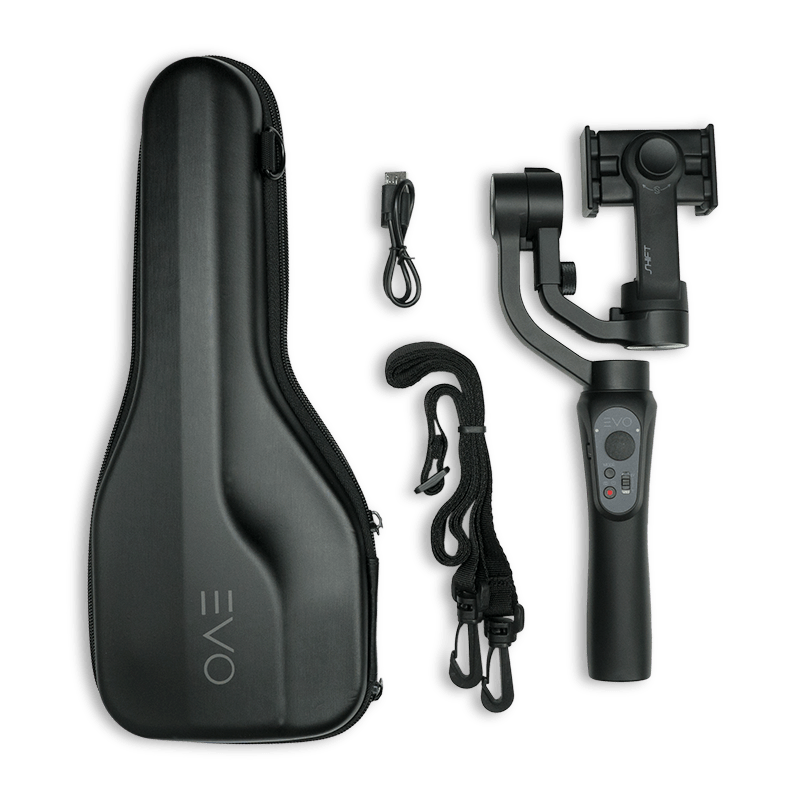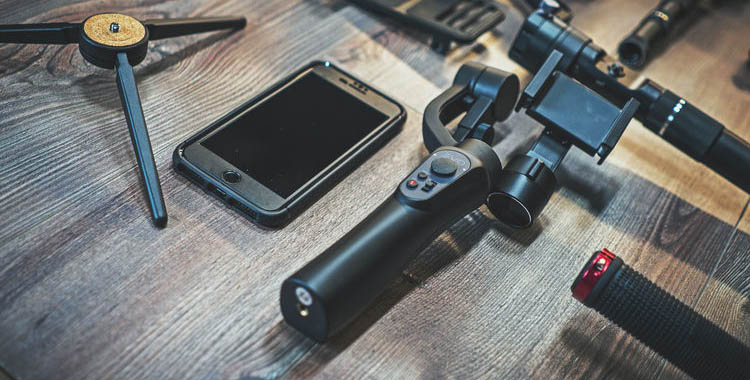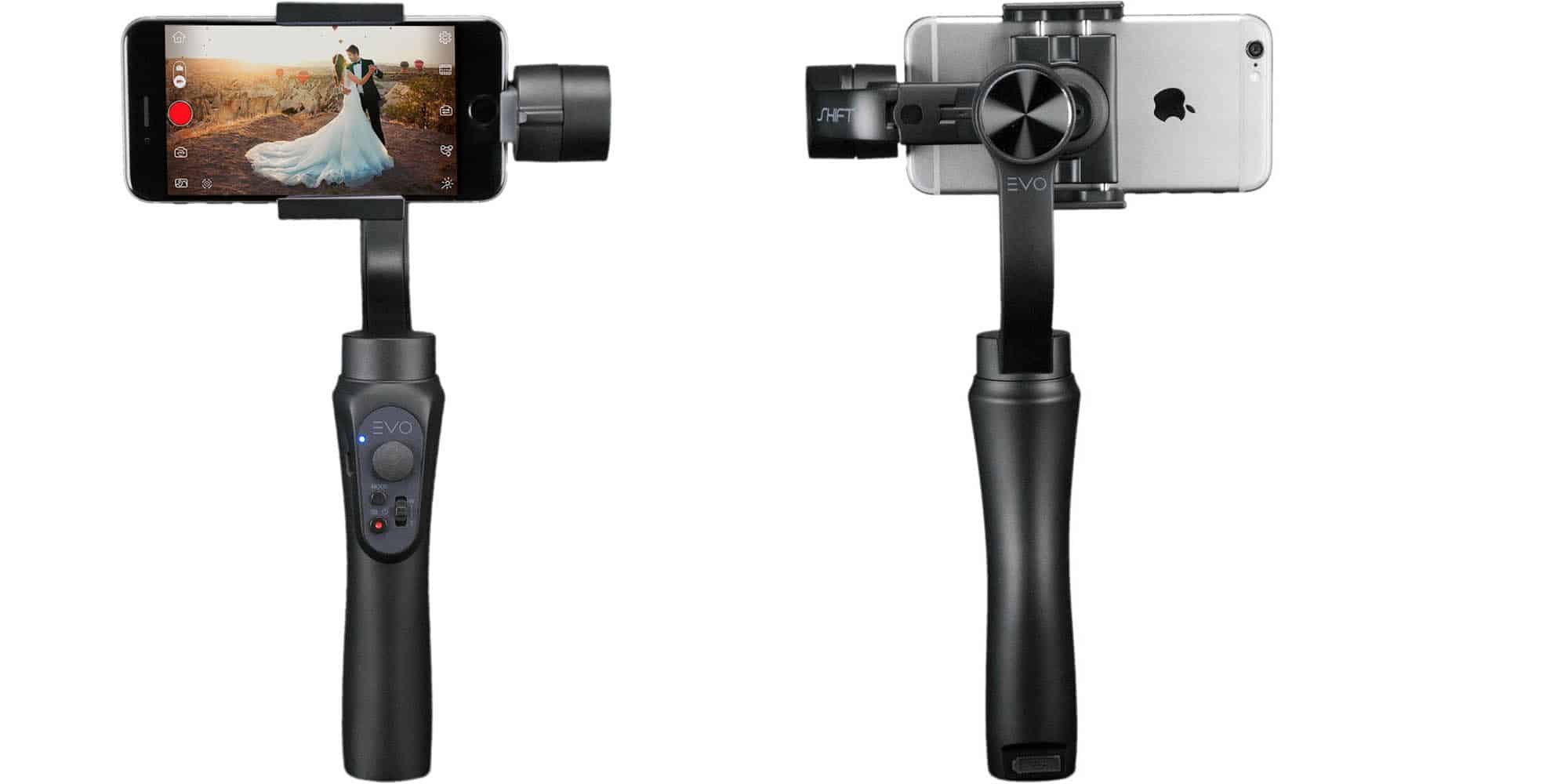Evo Gimbals pride themselves in being one of the few US based companies in a market dominated by Chinese manufacturers. They promise to offer superior, localized customer support. They’ve produced gimbals for smartphones in the past, but never had much to offer the consumer on a budget—until now. The Evo Shift is marketed as their ‘consumer grade’ smartphone gimbal stabilizer, and that’s what I’ll be checking out today.
First Impressions

The Evo Shift comes in a sleek black semi-hard case that almost looks like a guitar case.
Bundled with the gimbal you’ll find the user manual and micro USB charger—the setup is quite minimal and lacks a mini tripod that many other budget gimbals include in the box.
Whereas Evo’s popular GP-Pro and SP-Pro gimbals were constructed using aircraft grade aluminium, the budget-friendly Shift is built entirely from ‘durable plastic’ that doesn’t have a particularly premium feel.
Ergonomically, the hand grip is a little small but otherwise comfortable. The lack of a rubberized grip makes it feel more slippery than those that do have one.
Mounting your phone onto the Evo Shift is incredibly straightforward. Its adjustable spring loading mechanism can be adjusted on the fly to fit devices of various sizes.
Compatibility
The Evo Shift is compatible with most, with the following being officially supported:
iPhone Compatibility: All iPhone SE, iPhone 6/6+, 7/7+, 8/8+ and X/Xs Models
Android Compatibility:
- Samsung Galaxy S5, S6, S8*, S8+*, S9*, S9+*
- Samsung NOTE7*
- Google Pixel*
- HUAWEI Mate S, 8 and 9
- HUAWEI P9, P10 and P10 Plus
- LG G5*
*Requires Android 5.0 or later.
With a max payload of 220g and a max phone depth of 10mm being supported, the Evo Shift would appear to have no problem with phablet sized phones. The website does suggest a counterweight (purchased separately) is needed for Plus sized phones, but I did not use one for my iPhone 8 Plus. It may be needed for bigger and heavier phones.
You are also able to use the Evo Shift with GoPros or similar sized action cameras. Since it’s primarily designed for use with smartphones, mounting action cameras feels slightly unstable, so I’d personally recommend looking into getting a GoPro/action camera case adapter for the Evo Shift.
Evo Shift Features

Being Evo’s entry level smartphone gimbal, the Shift makes do with fairly basic features.
Its standout feature is perhaps its large capacity 26500mAh battery that gives it a battery life of approximately 10-12 hours. The Evo Shift also sports a USB port meaning it can be used as a portable powerbank as well.
The Evo Shift has an excellent range of motion. Although not particularly useful, it is able to continuously pan 360-degrees an unlimited number of times. The phone can also be setup in landscape and portrait modes.
At the base of the gimbal is a 1/4 inch thread needle. This allows you to easily mount it on a tripod.
Controlling the Evo Shift
The Evo Shift has a basic and straightforward control scheme that is easy to get used to.
After powering the gimbal on, the gimbal will automatically balance the mounted smartphone and be in be ready to shoot in pan follow mode. Pan follow mode will keep the camera’s horizon steady, meaning it will counteract any movements made in the tilt (up and down) axis. However, it will follow any panning movements.
You can press the mode button twice to go into follow mode. The Evo Shift will follow movements in both the pan and tilt axes, albeit with movements being smoothed out and much less shaky than you’d get when recording without a gimbal.
Finally, the locked mode keeps the camera’s orientation steady, meaning it will stay focused and negate any changes in the pan, roll and roll axes.
You can get a better idea about its modes through this video:
If you record through the Evo Gimbals Remote App you can also use the physical zoom slider on the handset to zoom in and out. Unfortunately, as is the case with practically ever physical zoom slider on smartphone gimbals, zooming in and out is not smooth and you can very clearly see the zoom being done in increments.
Speaking of the Evo Gimbals Remote App, the app also has an intelligent tracking feature that makes the gimbal focus onto a target and follow its movements. That’s great for certain applications like if you want to step away from the camera and have it automatically track your movements.
Stabilization Performance
The Evo Shift features good stabilization but it definitely performs more like a budget 3-axis gimbal. I’d compare it to the Hohem iSteady Mobile and Zhiyun Smooth Q which perform almost identically and cost less. It definitely feels like you’re paying a premium for the Evo brand alone.
Being a 3-axis gimbal stabilizer, it will still produce much, much more stable footage than relying solely on your smartphone’s optical image stabilization.
Note that if you’re using an iPhone, the gimbal doesn’t always play well with the iPhone’s built in image stabilization. There can be some conflict between the two, often producing quirky results.
I therefore recommend iPhone users to record with a third party app that allows you to record with OIS disabled. Many iPhone filmmakers currently recommend the Pro Movie app.
Conclusion
With the current quality of smartphone cameras being so good, the ‘smartphone filmmaker’ has been born. And with the Shift, Evo Gimbals clearly made an attempt to go after these casual and budget-conscious filmmakers.
The Evo Shift is the cheapest Evo gimbal we’ve seen to date and while it lacks the premium feel of their previous high-end gimbals, it’s a perfectly solid gimbal.
Unfortunately, the Evo Shift is still comparably more expensive than other entry-level gimbals on the market, with no features that really warrant the difference in price. Evo outsource gimbal manufacturing to China, so you can’t really argue production costs are higher.
Of course you get US aftercare but is that really enough to justify paying significantly more? For a $1000 professional-grade gimbal, maybe. But for a budget smartphone gimbal? I’ll leave that for you to decide!
Pros
- Good image stabilization
- Responsive customer support from a US based company
- Long battery life
Cons
- Poor value for money
Rating: 3.5/5
Looking for a gimbal for your iPhone? Check out my list of recommended gimbals for iPhone.
